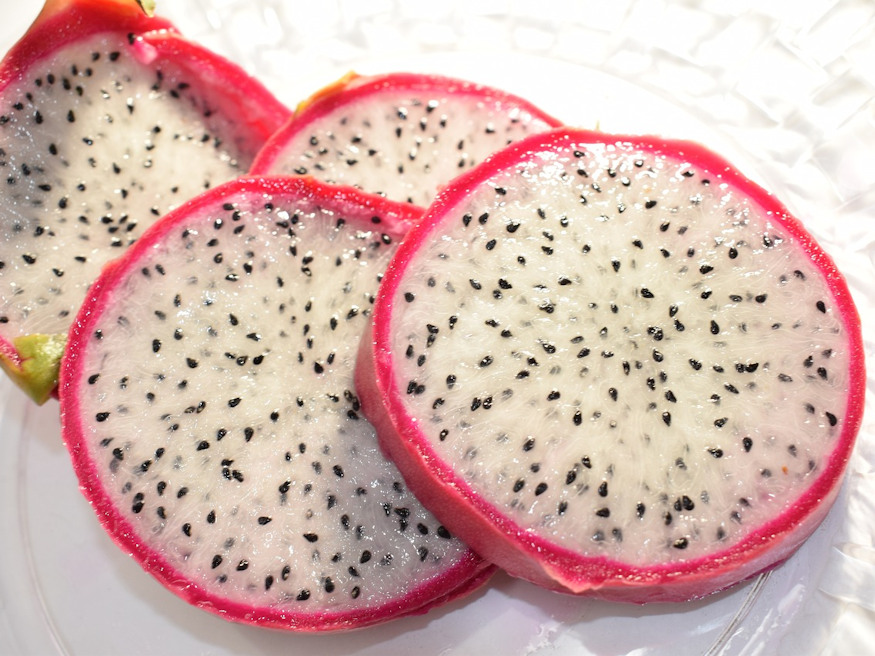Discover the enchanting world of dragon fruit, a captivating tropical fruit with a striking appearance and a wealth of culinary possibilities. Renowned for its vibrant hues, succulent flesh and numerous health benefits, dragon fruit is an enticing addition to any plant lover’s palate. Join us as we delve into the origins, cultivation techniques and delightful uses of this extraordinary cactus fruit.
Dragon fruit, also known as pitaya, is a tropical fruit that has gained popularity in recent years due to its unique appearance and potential health benefits. Here’s some information about dragon fruit in terms of its origin, appearance, cultivation and culinary use:
Origin
Dragon fruit is native to Central America and is believed to have originated in Mexico. It is now cultivated in various tropical and subtropical regions worldwide, including Southeast Asia, Australia and parts of the Americas.

Appearance
Dragon fruit has a distinctive appearance. It is a type of cactus fruit with a vibrant, bright-colored exterior. The most common variety has a deep pink or magenta skin with scales or spikes, resembling a mythical dragon, hence its name. There are also varieties with yellow or white skin. The fruit is oval-shaped or slightly elongated, typically about the size of a grapefruit.

Cultivation
Dragon fruit is cultivated by growing epiphytic cacti from the genus Hylocereus or Selenicereus. These cacti require a tropical or subtropical climate with well-drained soil. They are typically grown from cuttings or seeds. Dragon fruit plants have climbing or trailing vines, and they produce large, white, fragrant flowers at night. After pollination, the fruit develops and ripens within 30 to 50 days. The plants require support structures, such as trellises, for optimal growth.

Use and Culinary Aspects
Dragon fruit’s vibrant appearance and delicate flavor make it a versatile ingredient in various culinary creations. Its refreshing taste and mild sweetness make it a delightful addition to smoothies, fruit salads and tropical fruit bowls. The vibrant pink or white flesh of dragon fruit can be blended into colorful smoothies, mixed with other fruits in salads for a pop of color, or used as a topping for yogurt and granola bowls. Additionally, it can be incorporated into desserts such as sorbets, ice creams, cakes and even cocktails, lending a unique visual appeal and subtle sweetness to these treats.

Some examples of dishes made using dragon fruit include:
- Dragon Fruit Smoothie Bowl: A nutritious and visually stunning breakfast bowl made by blending dragon fruit with frozen berries, bananas and a splash of coconut water, topped with granola, fresh fruits and a drizzle of honey.
- Dragon Fruit Salad: A refreshing summer salad featuring a combination of dragon fruit, watermelon, cucumber and mint leaves, dressed with a tangy lime dressing for a burst of flavors.
- Dragon Fruit Popsicles: A healthy and delightful frozen treat made by pureeing dragon fruit with coconut milk, adding a touch of honey or agave for sweetness, and freezing the mixture in popsicle molds.

- Dragon Fruit Cheesecake: A luscious dessert with a vibrant pink hue, created by incorporating dragon fruit puree into a creamy cheesecake filling and topping it with fresh dragon fruit slices for an impressive presentation.
- Dragon Fruit Margarita: A tropical twist on the classic margarita, made by blending dragon fruit with tequila, lime juice and a hint of agave syrup, served in a salt-rimmed glass garnished with a dragon fruit wedge.

These are just a few examples, and the culinary possibilities with dragon fruit are vast. It pairs well with other tropical fruits, complements creamy textures, and adds an exotic touch to a variety of dishes, allowing chefs and home cooks to explore their creativity in the kitchen.

Interesting Facts
- Dragon fruit is considered a tropical superfood due to its rich nutritional profile. It is low in calories and high in fiber, antioxidants and vitamin C.
- There are several varieties of dragon fruit, including the white-fleshed variety (Hylocereus undatus) and the red-fleshed variety (Hylocereus costaricensis).

- The flowers of the dragon fruit plant are pollinated at night by bats, moths or other nocturnal creatures. They are large and fragrant to attract these pollinators.

- Dragon fruit plants can produce fruit for several decades if well-maintained.
- In addition to its culinary uses, dragon fruit is also used in traditional medicine in some cultures for its potential health benefits, such as promoting digestion and boosting the immune system.









